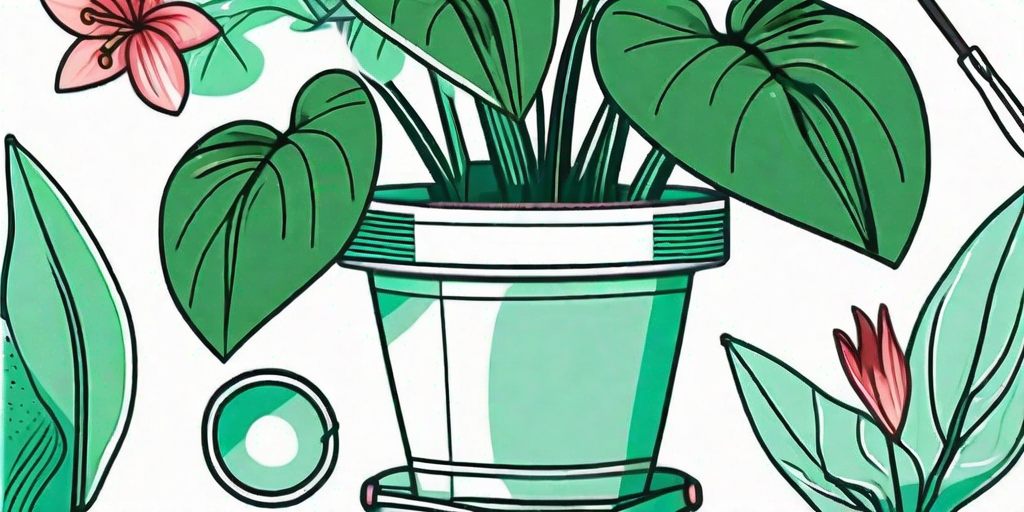
Welcome to the world of houseplants, where the green Anthurium reigns supreme with its glossy, heart-shaped leaves and vibrant spathes. If you're a plant enthusiast or just someone looking to add a touch of nature to your living space, you've come to the right place. Let's dive into the lush world of this tropical beauty.
Understanding the Green Anthurium
Native to the tropical rainforests of Central and South America, the green Anthurium, also known as the Flamingo Flower, is a sight to behold. With its glossy foliage and unique, heart-shaped spathes, this plant is a true showstopper.
But don't be fooled by its exotic looks. The green Anthurium is surprisingly easy to care for, making it a favorite among both novice and experienced plant parents. So, if you're ready to add this stunning houseplant to your collection, read on.
The Anatomy of the Green Anthurium
The green Anthurium is known for its large, glossy leaves that come in a variety of shapes, from heart-shaped to lanceolate. These leaves can grow up to 15-20 inches long, giving the plant a lush, tropical appearance.
The real showstopper, however, is the plant's spathe, which is often mistaken for a flower. This heart-shaped structure, which can be green, red, pink, or white, is actually a modified leaf that surrounds the plant's true flowers, which are found on the spadix, a spike that emerges from the spathe.
How to Grow and Care for Your Green Anthurium
Now that we've covered the basics of what makes the green Anthurium so special, let's get down to the nitty-gritty: how to grow and care for this stunning houseplant. Fear not, dear reader, for this is a journey we shall embark on together.
Lighting and Temperature
Like most tropical plants, the green Anthurium thrives in bright, indirect light. Too much direct sunlight can scorch the leaves, while too little light can cause the plant to become leggy and sparse. So, find a spot in your home that gets plenty of natural light, but is shielded from the harsh afternoon sun.
As for temperature, the green Anthurium prefers warm conditions, ideally between 65 and 85 degrees Fahrenheit. Keep your plant away from drafts and sudden temperature changes to keep it happy and healthy.
Watering and Feeding
The green Anthurium likes to be kept moist, but not waterlogged. Water your plant thoroughly, then allow the top inch of soil to dry out before watering again. Overwatering can lead to root rot, a common problem among houseplants.
Feeding your green Anthurium is also crucial for its growth and health. Use a balanced, water-soluble fertilizer every two weeks during the growing season (spring and summer) and once a month during the dormant season (fall and winter).
Pruning and Repotting
Pruning your green Anthurium is not only beneficial for the plant's health, but it also helps maintain its shape and size. Remove any yellow or brown leaves and trim back any leggy growth to keep your plant looking its best.
Repotting your green Anthurium every two to three years can also help keep it healthy. Choose a pot that's one size larger than the current one and use a well-draining potting mix to ensure proper drainage.
Common Problems and Solutions
While the green Anthurium is relatively easy to care for, it's not immune to problems. Here are some common issues you might encounter and how to solve them.
Yellow Leaves
If your green Anthurium's leaves are turning yellow, it could be a sign of overwatering. Check the soil's moisture level and adjust your watering schedule accordingly. Remember, it's better to underwater than overwater.
Brown Tips
Brown tips on the leaves could indicate a lack of humidity. Try misting your plant regularly or place it on a tray filled with pebbles and water to increase humidity levels.
Leggy Growth
If your green Anthurium is becoming leggy, it might not be getting enough light. Move your plant to a brighter location, but avoid direct sunlight to prevent leaf scorch.
Frequently Asked Questions
- Is the green Anthurium toxic?
Yes, the green Anthurium is toxic if ingested. Keep it out of reach of children and pets. - How often should I water my green Anthurium?
Water your green Anthurium when the top inch of soil feels dry to the touch. - Why are the leaves on my green Anthurium turning yellow?
Yellow leaves can be a sign of overwatering. Check the soil's moisture level and adjust your watering schedule accordingly.
And there you have it, folks! A comprehensive guide to growing and caring for the stunning green Anthurium. With a little love and care, this tropical beauty will reward you with its lush foliage and vibrant spathes. So, what are you waiting for? Unleash the beauty of the green Anthurium today!















